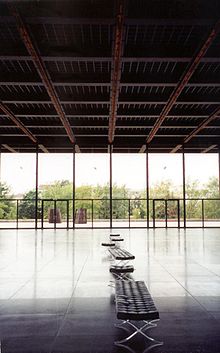- Neue Nationalgalerie
-
Neue Nationalgalerie at the Kulturforum is a museum for modern art in Berlin, with its main focus on the early 20th century. It is part of the Nationalgalerie of the Staatliche Museen zu Berlin. The museum building and its sculpture gardens were designed by Ludwig Mies van der Rohe and opened in 1968.
Contents
Collection
The collection features a number of unique highlights of modern 20th century art. Particularly well represented are Cubism, Expressionism, the Bauhaus and Surrealism. The collection owns masterpieces of artists like Pablo Picasso, Ernst Ludwig Kirchner, Joan Miró, Wassily Kandinsky and Barnett Newman. The design of the building, despite its large site, allows for the display of only a small part of the collection, and the displays are therefore changed at intervals. In 2010 and most of 2011 the display covers the period 1900–1945; from late 2011 post-war art will be the next exhibition.
Architecture
Built in 1968, the Neue Nationalgalerie was the first building completed as a part of Berlin’s Kulturforum, a cluster of buildings dedicated to culture and the fine arts. The architecture of the museum is, according to its admirers, a powerful and expressive object in itself. Nearly all of the museum's collections are located within in a stone podium, solid to protect the art from damaging daylight, partially in the ground of the sloping site, with windows only on one side facing a walled sculpture garden. A minimalist steel and glass pavilion, located on the paved roof plaza above the podium, serves as the entrance lobby and the special exhibit gallery. The pavilion, while a small part of the museum, is the primary architectural expression. Its structure consists of a large steel roof deck supported by eight exterior columns, creating an effect of a shelter with a single floating plane. Large glass sheets that define the interior space are set far back from the roof edges, framed by delicate steel mullions. The glass walls and the elimination of all interior columns emphasizes the idea of free space as a place for artists to present their work, unencumbered by the necessity of a shelter to protect visitors and contents from the elements. Natural light transmitted through these walls reflects off the dark, highly polished floor, emphasizing the extension of space beyond the boundaries of the interior, a symbolic removal of solid walls as barriers. The podium roof plaza is itself another open air gallery for public sculpture, extending the exhibit space of the pavilion to the outside.
The unusual natural illumination, coming from around and below the viewer rather than above, and the continuous suggestion of motion in the ceiling, combine to shock the viewer out of his or her usual way of seeing, perhaps preparing the audience to bring a fresh eye to the art housed below. Yet, at the same time, the simplicity and rigorously pure geometry of the space's rectangular forms makes the design seem tranquil, rather than obtrusive. This careful balance of free-flowing space and a stable arrangement of architectural components is typical of Mies van der Rohe's mature style.
Art installations
The museum's ceiling, constructed as a grid of black-painted steel grid of beams, has been used as an exhibit surface in itself when used for an installation of long lines of LCD displays by artist Jenny Holzer in 2001, which continuously scrolled abstract patterns down their length.
Images
See also
- Alte Nationalgalerie
- List of museums in Berlin
External links
- http://www.smb.museum/nng
- http://www.kulturforum-berlin.com/engl_index.html
- "Designs by Mies van der Rohe for the Neue Nationalgalerie, Berlin". Architecture. Victoria and Albert Museum. http://www.vam.ac.uk/collections/architecture/Objects_in_architecture/mies_van_der_Rohe/index.html. Retrieved 2011-15-03.
Coordinates: 52°30′24.5″N 13°22′04.5″E / 52.506806°N 13.367917°ECategories:- Buildings and structures completed in 1968
- Ludwig Mies van der Rohe buildings
- Art museums and galleries in Berlin
- Modern art museums
- Modernist architecture in Germany
Wikimedia Foundation. 2010.





